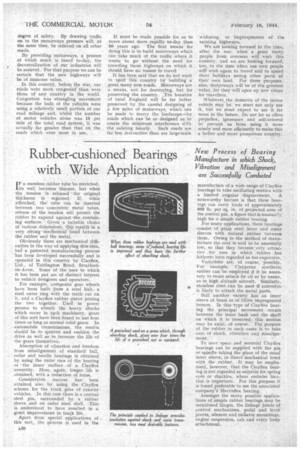Rubber-cushioned Bearings with Wide Application
Page 32

If you've noticed an error in this article please click here to report it so we can fix it.
New Process of Bearing Manufacture in which Shock, Vibration and Misalignment are Successfully Combated
F a seamless rubber tube be stretched, tits wall becomes thinner, but when the tension is released the original thickness is regained: If, while stfetched, thea tube can be inserted between two concentric metal tubes, release of the tension will permit the rubber to expand against :the. containing surfaces. Given .a suitable chojce of various dimensions, this results in a very strong -mechanical bond between the rubber and the Metal.
Obviously there. are mechanical difficulties in the way of applying this-idea, but. a patented manufacturing, process has been developed successfully and is operated in this country by Clayflex, Ltd., of Tiddington 'Road, StratfordOn-Avon, Some of the uses to which it has been put are of distinct interest to vehicle designers and operators.
For example, composite gear wheels have been built from a steel hub, a steel outer ring with the teeth cut on it, 'and a Clayflex rubber sleeve joining the two together. Used in power presses to absorb the heavy shocks which occur in sqch machinery, gears , of this sort have been found to last four times as long as normal solid gears. In
• automobile transmissions, the results should be to quieten and cushion the drive as well as to increase the life of the gears themselves.,
Absorption of vibration and freedom from misalignment of standard ball, roller and needle bearings is obtained by using the outer race of the bearing as the inner surface of a Clayflex assembly. Here, again, longer life is obtained, with a reduction of noise.
Considerable success has been • attained also. by using the Clayflex scheme for the track pins of crawler vehicles. In this case there is a central steel pin, surrounded by a rubber sleeve and an outer steel shell. This is understood to -have resulted in a great improvement in track life. Apart from special applications of this sort, the process is used in the' manufacture of a wide range of Clayflex bearings to take oscillating motion with a limited angular displacement. A noteworthy feature is that these bearings can carry loads of approximately 60,0 lb. per sq. in, of projected area of the central pin, a figure that is unusually high for a simple rubber bearing.
For many applications, these bearings consist 'of plain steel inner and outer sleeves with natural rubber between them. Owing to the method of manufacture the cost is said to be unusually low, so that they become very attractive for uses in which rubber has hitherto been regarded as too expensive.
Variations are, of course, possible. For example, Clayprene synthetic rubber can be employed if it be necessary to resist attack by oil or by ozone, as in high altitude aircraft. Similarly, stainless steel can be used if corrosion is likely to attack the metal parts.
Still another variety has an inner sleeve of brass or of Oilite impregnated bronze. In this type of Clayflex bearing the principal movement occurs between the inner bush and the shaft on which it is mounted; this motion may be axial, of course. The purpose of the rubber in such cases is to take care of shock, vibration and misalign ment. , To save space and material Clayflex bearings can be supplied with the pin or spindle taking the place of the usual inner sleeve, in direct mechanical bond with the rubber. It may be emphasized, however, that the Clayflex bearing is not regarded as suitable for spring eyes or shackles, where endwise location is important, For this purpose it is found preferable to use the associated company's Harrisflex bearing, Amongst the many possible applications of simple rubber bearings may be mentioned hinges, the linkage joints of control mechanisms, pedal and lever pivots, silencer and radiator mountings, 'engine suspension, cab and every body attachment.




















































